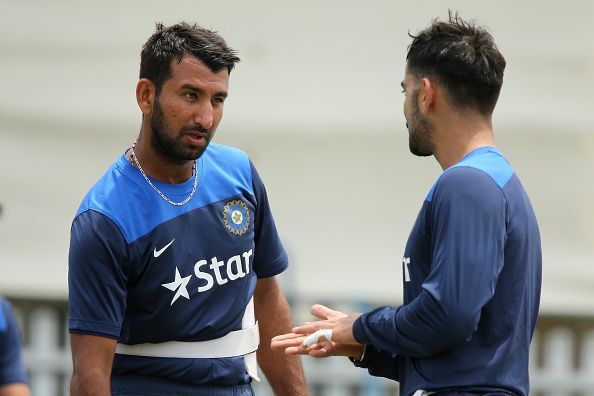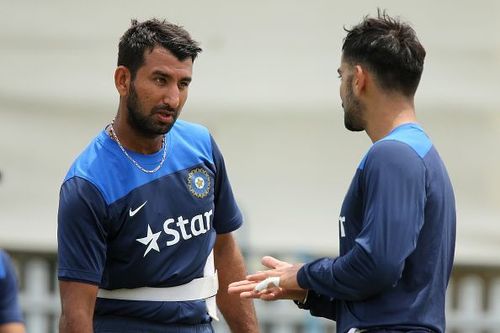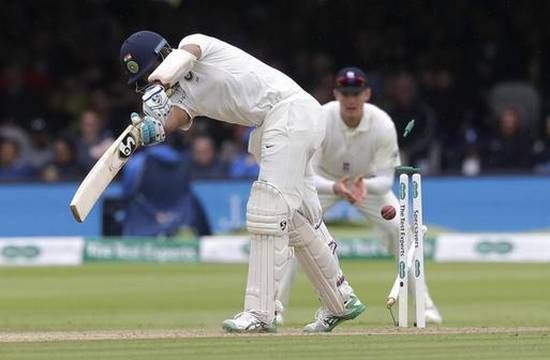
Why Cheteshwar Pujara is receiving a lot of flak

Technique and resilience are the keywords that come to mind, when a batsman plays in England. Cheteshwar Pujara certainly has a lot of resilience. After playing a stint of county cricket with Yorkshire just before India’s tour to England, one felt that amongst all Indian batsman, he would have the best experience of English conditions and would be an automatic selection into the team. It was hence very surprising that he was dropped for the first test match.
Test match cricket has come a long way since the 2000s. Most of the matches played these days are getting over in less than 5 days. Consider this, between 2010 and 2015, a total of 246 test matches were played out of which 185 produced a result. Of these 185 matches, 76 matches ended in four days and 28 in three days.
This evolution of test cricket is due to a number of factors, pitches being tailored to suit home teams, touring teams performing poorly and the advent of T-20 cricket. The last factor, I believe, has played a major role in the earlier than scheduled completion of test matches.
The #3 position for any batting team is vital. If as a batsman you come in when the scoreboard reads 100/1, then the primary role is to keep the scoreboard ticking. On the other hand, if the batsman comes in at 0/1, then he must assess the conditions and play accordingly and maybe even take the attack to the opponents.
In short, play the situation on its merit. Consider the likes of Ricky Ponting and Michael Vaughan, when they would come in to bat at #3, the scoreboard always kept ticking. They have faced tough times, swinging ball, green pitches but they have also always found a way to score runs.
Michael Vaughan’s 166 at Edgbaston in 2005 Ashes series was a typical example of this. The openers and the #3. batsman lay the foundation for the team to put up a good total.
Cheteshwar Pujara’s overseas record is pretty poor. In away matches, he averages 34 and has a strike rate of 41. Consider the innings he played at Lord’s in the second test match wherein he scored 17 off 87 balls in the first innings and 1 off 25 in the second. In conditions like England where the ball nips around constantly, as a batsman whether you are at the crease playing on 100* or 0*, you can always get out with the slightest of carelessness.
In short, you are never set and the ball always dominates. In such scenarios, keeping the scoreboard ticking is vital. Intent to score is a very important characteristic for any batsman. Rewind to Ajinkya Rahane’s innings in 2014 at Lords when he scored a century in bowler friendly conditions. Rahane scored 103 off 154 balls at a strike rate of 67. This is the intent which is being spoken about here.
Coming back to Pujara’s innings at Lords, having faced 87 balls in the first innings, one would have thought that even though his strike rate is low, he would have got a feel of the conditions and identified his run scoring opportunities.
Unfortunately, he got dismissed. This emphasizes the point that run scoring at very possible opportunity is vital in seaming conditions.
As a result of T-20 cricket, batsman today, even in test matches think of scoring a run off every ball. There has been a paradigm shift in the mindset of a batsman from the earlier defend to survive mode to the present, taking the attack to the bowler mode and to use every run scoring opportunity to the fullest. This is where Pujara is at a disadvantage since he only plays test match cricket and no other format.
Pujara received a lot of flak for his slow innings and when you consider his dismissal in Trent Bridge in the first innings, he got out trying to hook a ball in the last over before lunch. This shows that he came out with an intent to score, but chose the wrong moment. During the last over before lunch, there was no need to play that shot.
I feel that there is a lack of clarity in his batting style. He is in two minds as to whether to play the role of defence and survive or to show intent and attack. He is naturally suited to the former, and ups his scoring ante once he is settled. But with modern day test cricket, wherein teams almost score at 4 runs per over right from the outset, his style is caught wanting.
The last time, I can think of a team trying just to survive was South Africa against Australia in Adelaide in 2012 when the Proteas batted out 148 overs to save a test match.
Pujara though has done very well for India in home conditions. He averages a mammoth 62 and has got 10 centuries to his name, which shows that he is a talented batsman. It would be foolish to write him off.
At the very beginning of his career, he was slated to be the next ‘Wall’. For India as well as for himself, he needs to quickly work on the tempo of his innings and come up with better scores overseas, else his spot will be under threat.
Having not made any significant contribution in India’s previous tour to South Africa as well, time could be ticking very quickly for him. The 72 off 208 balls in the second innings at Trent Bridge should give him some confidence and he would really hope to carry this momentum into the last two matches and come up with bigger scores.
